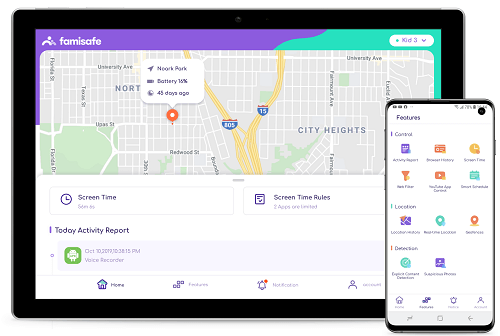Different Types of Learning Styles: How do Your Kids Learn?
Teach Your Kids According to Their Learning Styles
ALL TOPICS
- YouTube Parental Control
-
- How to see your YouTube history?
- What is Metaverse? Parent Guide
- Put parental controls on YouTube
- Delete TikTok Account without Phone Number
- Ways to block YouTube channels
- Ways to Get Somone's IP Address and Hide IP Address
- A complete guide on YouTube parental control
- What is Fanfiction? Parents Guide
- Kids safe YouTube alternative
- Top 5 TikTok Alternatives
- Methods to restrict YouTube adult content
- Social Media App Parental Controls
- Parental Control Tips
Sep 11, 2024 Filed to: Health & Education Proven solutions
Everybody is different in their unique way. This is even more profound when dealing with children and their way of comprehending and processing information. A learning style is a way a student prefers to learn; every child has their way of understanding, absorbing, processing, and retaining information when they are being taught. With that in mind, let’s look at the different types of learning styles.
What Are the Different Learning Styles?
You may be wondering: What are the different learning styles? There are four common types of learning styles: Visual learning, auditory learning, kinesthetic learning, and reading and writing learning style. Here is a quick review of different learning styles.
1. Visual Learning
In this type of learning, the students have to learn using images. They are partial to observation and seeing things such as pictures, maps, and diagrams. This kind of learning style is sometimes called the spatial learning style. Learners who study through sight comprehend information better when you give them visual information.
Visual learners have great spatial awareness and a good sense of direction. They easily visualize plans and outcomes, and they love doodling, drawing, and coloring. They are good at using maps and rarely get lost. When dealing with these kinds of learners, you should give them opportunities to draw images and diagrams on the board or even ask them to doodle some examples related to the topic of the day. They often observe the visual cues, so you might want to give them time to process the visual materials.

2. Auditory Learning
You might be wondering: What are the different learning styles for kids who are good listeners. Auditory learning is whereby students learn through listening. Auditory Learners perform best when you present information to them vocally. They depend on speaking and listening as their way of learning. Auditory learners grasp information best when it's presented in different strategies that may involve talking like in group discussions and lectures.
Auditory learners have a good sense of rhythm and pitch. They are very skilled when it comes to oral reports and class presentations. These learners enjoy listening to music playing in the background as they go about their learning and can work their way through complex problems simply by talking out loud. These types of learners don’t like taking notes in class because they want to maintain the order of their unbroken auditory attention.

3. Reading and Writing Learning Style
Reading and writing learners grasp information best when they put things in writing. They do this by writing down the concept or by reading it. Unlike the visual and auditory learners, the reading and writing learners find information put together in text form to be more powerful. They perform exceedingly well when it comes to written assignments. You need to encourage these types of learners to take notes during class sessions to help them process and retain the information. While these learners enjoy taking part in writing and reading activities, they also have excellent verbal expression skills and like to ask questions. They enjoy learning new words and can easily learn new languages.

4. Kinesthetic Learning
Also known as tactile learning, kinesthetic learning is a learning style that involves people carrying out physical activities. For that reason, people often call these types of students physical learners. Kinesthetic learners are hands-on kind of learners and utilize touch for the best results. Physical learners use all their senses in equal proportions in the learning process.
Kinesthetic learners are often more successful in scientific learning areas that involve lab component because the skill-based training in these settings often engages them in various productive ways. They always have high energy levels and will always take notice of the physical world around them. Because of their high energy levels, they enjoy participating in sports and other outdoor activities that involve working with their hands. Once they have done something, they can duplicate it as they have excellent motor memory.
Educators can help these kinds of learners by incorporating learning games that have moved into their lessons. They can allow the learners to act out scenes from a certain book or lesson. Physical learning helps kinesthetic learners to better grasp and understand abstract ideas as well as difficult concepts.

What Can Parents Do To Help Kids With Different Learning Styles To Learn?
Parents play a huge role in helping their children settle best in their learning areas. They need to understand there are different types of learning styles, so they should know which one is suitable for their child to help them learn better. To help your kid, keep in mind that each learner has a different way of processing and retaining information. Below are six things parents can do to help their kids with different learning styles.
1) Encourage Your Child To Say the Words Loud
If your child is an auditory learner, you may want to encourage them to use this method. Saying important words loud will help them retain information in their brain. You could have a mini spelling bee to help your child with spelling. Alternatively, you buy audiobooks and encourage them to read along loud.
2) Surround Your Child With Books
You may want to surround your children with books if they are visual learners, even if they cannot read. Visual learners are interested in bright pictures and stories, so it's always a good idea to keep books near them.
3) Stock up Supplies for Visual Representation
By doing so, you will help the learner to remember all concepts that you teach them. Ensure you stock up art supplies the learners can use to create imagery representations of their learning areas. They can create drawings that can help them remember important elements of a story and solidify the meaning of new concepts in their memory.
4) Create a Quiet and Non-Distracting Space To Learn
Settings that have lots of sights, sounds, and colors can cause distractions when students are learning. Creating a quiet space with fewer distractions can help them focus more on their learning. You can use this tip for different types of learning styles.
5) Provide Interesting Learning Aids
Help your child learn math concepts better by getting them physical manipulative like pattern blocks and Dienes blocks. You can even put letter-shaped magnets on the fridge for them to play with and form simple words.
6) Encourage Them To Write More
Encouraging reading and writing learners to write frequently is a great idea. Encourage your child to take notes and write down acronyms to help them memorize concepts. Get them engaging books to read and encourage them to write up the events of the day in their diaries. In turn, they will feel more in control of themselves and start enjoying learning.
FamiSafe Helps Kids form Good Study Habit
Now that you know the different learning styles, you should learn how to make sure your kids concentrate on their studies. New technology means that many schools are increasingly using e-learning in classrooms throughout the world. For this reason, parents have to provide their kids with technical gadgets to help them learn. You can use FamiSafe to help your kids to form good study habits.
- Location Tracking & Geo-fencing
- App Blocker
- Web Filtering
- Screen Time Control
- Smart Parental Control Setting
Here is how this app can help you.
You don't want your kids' to have too much screen time. With FamiSafe, you can block apps that you think might distract your kids during study hours. The app records the history of the browser and the apps on your kids' devices.
FamiSafe's Smart Schedule allows you to control when and where your kids can use their devices. The app also allows you to reward your children with more screen time when they complete the tasks that you had given them. What's the best part? You can control multiple devices with this app.
Sometimes children may find themselves on dangerous platforms while learning online. You can use the web filtering feature to restrict your children from accessing explicit or gaming content when using their devices to learn. With the FamiSafe app, parents can get alerts when their kids access suspicious sites or apps.
So if you were asking yourself what are the different learning styles and how can I makes sure my kid focuses on school? This article has answered your questions.
Learning is an on-going activity that never ends, regardless of your age. People are different and take in information differently. Parents need to understand that each child is unique, so they can each learn using different learning styles. Once parents understand which learning style fits their kid, it becomes easier to know how to help them learn. Remember that FamiSafe helps to ensure that your children focus on studying.


Ankhi Bhattacharya
contributor Editor